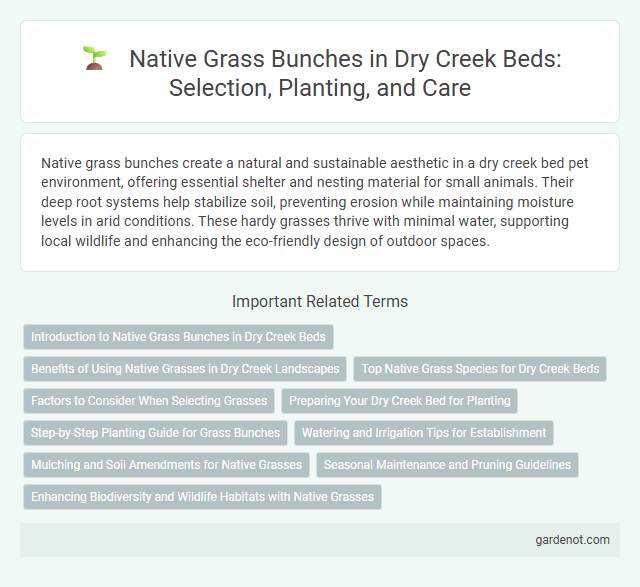Native grass bunches create a natural and sustainable aesthetic in a dry creek bed pet environment, offering essential shelter and nesting material for small animals. Their deep root systems help stabilize soil, preventing erosion while maintaining moisture levels in arid conditions. These hardy grasses thrive with minimal water, supporting local wildlife and enhancing the eco-friendly design of outdoor spaces.
Introduction to Native Grass Bunches in Dry Creek Beds
Native grass bunches in dry creek beds play a vital role in stabilizing soil and preventing erosion by forming dense, fibrous root systems that anchor sediment. These perennial grasses thrive in arid conditions, adapting to limited water availability while supporting local biodiversity and enhancing habitat complexity. Species such as big bluestem, little bluestem, and sideoats grama are common native bunch grasses found in dry creek ecosystems, contributing to natural water filtration and maintaining ecological balance.
Benefits of Using Native Grasses in Dry Creek Landscapes
Native grass bunches in dry creek beds enhance soil stability by reducing erosion through their deep, fibrous root systems. These grasses improve water infiltration and retention, supporting sustainable moisture levels in arid landscapes. Their natural adaptability minimizes maintenance needs and promotes local biodiversity, creating resilient and eco-friendly dry creek environments.
Top Native Grass Species for Dry Creek Beds
Top native grass species ideal for dry creek beds include blue grama (Bouteloua gracilis), big bluestem (Andropogon gerardii), and little bluestem (Schizachyrium scoparium), renowned for their drought tolerance and deep root systems. These bunch grasses effectively stabilize soil, reduce erosion, and enhance water infiltration in arid landscapes. Their adaptability to dry, low-nutrient environments makes them essential for sustainable creek bed restoration projects.
Factors to Consider When Selecting Grasses
Native grass bunch species thrive in dry creek bed environments due to their deep root systems, drought tolerance, and soil stabilization properties. Factors to consider when selecting these grasses include soil type compatibility, sunlight exposure, and water availability to ensure optimal growth and erosion control. Understanding the native ecosystem and seasonal growth patterns enhances the success of planting native bunchgrasses in dry creek beds.
Preparing Your Dry Creek Bed for Planting
Native grass bunches thrive in well-prepared dry creek beds with loose, well-draining soil to prevent waterlogging and promote root establishment. Remove debris and break up compacted layers to enhance aeration and water infiltration, ensuring optimal conditions for native species like blue grama or buffalo grass. Incorporate organic matter to boost soil fertility, supporting healthy growth and long-term stability of the native grass bunches.
Step-by-Step Planting Guide for Grass Bunches
Choose native grass bunch species suited for dry creek beds such as Blue Grama or Little Bluestem for optimal drought tolerance and soil stabilization. Prepare the site by loosening the soil to a depth of 6-8 inches and removing weeds to ensure healthy root establishment. Plant grass bunches 12-18 inches apart, water deeply after planting, and maintain consistent moisture for the first 4 weeks to promote strong root development.
Watering and Irrigation Tips for Establishment
Native grass bunches in dry creek beds require deep, infrequent watering to encourage strong root development and drought resilience. Watering should be adjusted based on soil moisture levels, typically allowing the top two inches to dry out between sessions. Irrigation methods such as drip systems or soaker hoses deliver water directly to the root zone, minimizing evaporation and promoting efficient water use.
Mulching and Soil Amendments for Native Grasses
Mulching native grass bunches in dry creek beds conserves moisture, reduces erosion, and suppresses weed growth, crucial for enhancing soil health in arid environments. Organic mulches like straw or wood chips decompose over time, improving soil structure and nutrient availability for native grasses. Soil amendments, such as compost or biochar, increase water retention and microbial activity, fostering robust root development and long-term sustainability of drought-tolerant native grass species.
Seasonal Maintenance and Pruning Guidelines
Native grass bunches in dry creek beds require seasonal maintenance to promote healthy growth and prevent overgrowth. Pruning should be conducted during late winter or early spring, removing dead or brown foliage to enhance airflow and sunlight penetration. Regular trimming helps maintain the plant's shape and supports new growth, ensuring the grass remains resilient during dry periods.
Enhancing Biodiversity and Wildlife Habitats with Native Grasses
Native grass bunches in dry creek beds play a crucial role in enhancing biodiversity by providing essential habitats and food sources for a variety of wildlife species. Their deep root systems stabilize soil, reduce erosion, and improve water infiltration, supporting the overall health of riparian ecosystems. These grasses also create microhabitats for insects, birds, and small mammals, promoting a balanced and resilient ecosystem.
Native grass bunch Infographic

 gardenot.com
gardenot.com